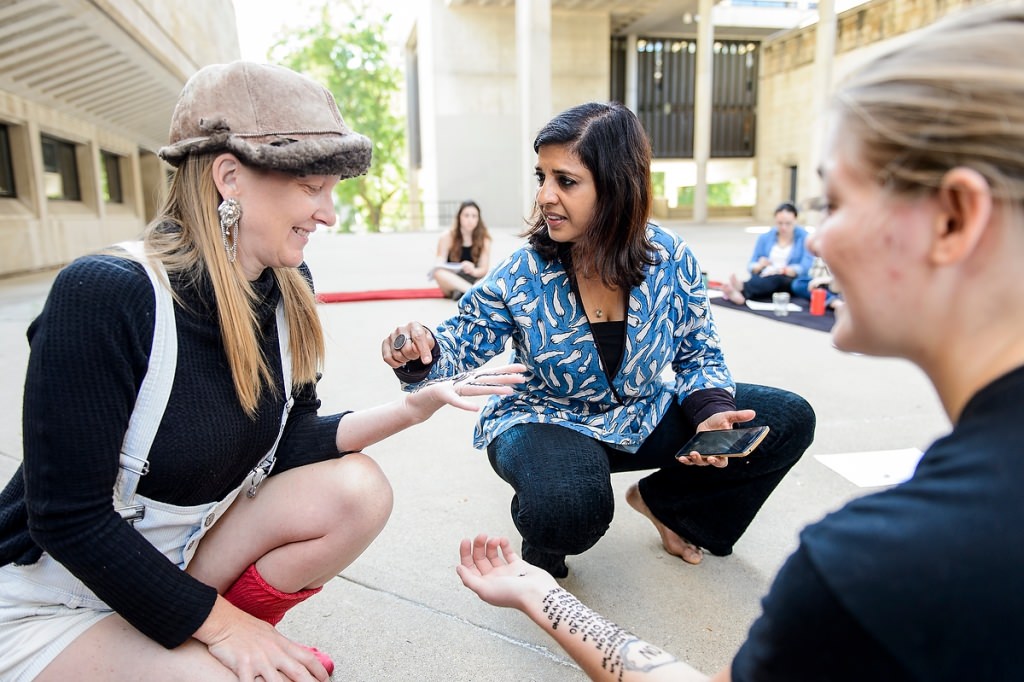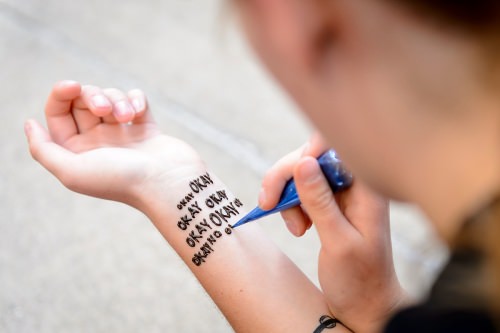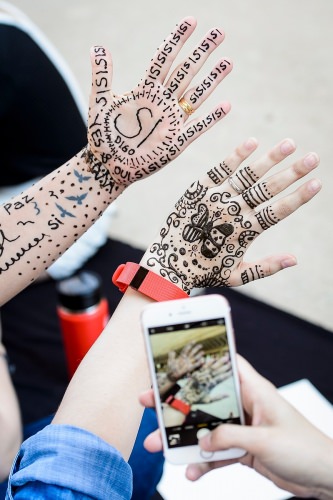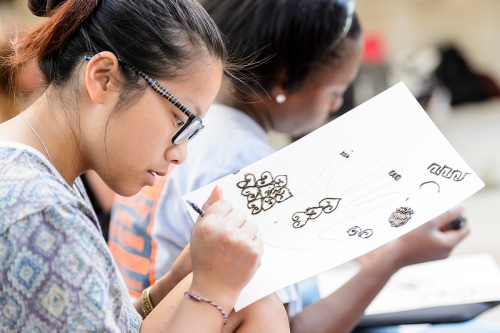Artist mixes traditional and contemporary; decorative and political

Meeta Mastani (center), Interdisciplinary Artist in Residence of the UW–Madison Arts Institute, conducts a “Creating Images with Henna” workshop on the outdoor terrace of the Humanities Building. Photo: Bryce Richter
Students sit outside on sunny concrete, intently applying henna, an Eastern plant-based temporary dye, to the backs of their hands. They squeeze out traditional geometric and floral designs, but they also carefully print words.
Luisa Fernanda Garcia-Gomez, a second-year design studies major from Colombia, holds up her open hand to the group and explains her design. “Sí,” is written in thick henna in the center of her palm, and smaller, repeated “sí”s line the inside of each of her fingers to the tip.
“My country now is in a 60 years war, but they are asking the people whether they want peace or not,” she says. “The country is very divided … I say, ‘Yes.’ Yes to peace.”
It’s not your typical henna design, and it’s not intended to be. This class is led by UW–Madison’s fall interdisciplinary artist-in-residence, Meeta Mastani. Her class on textiles will teach students about natural dyes and printing, but she also wants to encourage them to use their art to express their emotions and cultural and political beliefs.

Lucy Hodkiewicz used henna dye to create an emphatic message. Photo: Bryce Richter
“It’s so much easier to do the decorative than the political, so to be able to combine the two, to do the political in a decorative way, that excites me,” Mastani says.
Mastani, based in India, is an internationally known print and dye artist and design specialist. She co-founded a sustainable, fair-trade textile and craft business known as Bindaas Unlimited and works with artists across India, helping them contemporize their weaving, textiles, leatherwork, pottery and other crafts.
“I reinterpret tradition,” Mastani says. In India, there are many classical artisans who stick to the traditions of centuries, she says. She shows them ways to experiment and inject new elements into their art.
She’ll be doing the same for this class, “Tactile Textiles – From 2D to 3D,” part of the Interdisciplinary Arts Residency Program. For the program, artists teach a course for university credit, present at least one free public event and participate in community outreach activities, like the public henna event the class is hosting.
Mastani will teach the class about painting, printing and dyeing in non-toxic colors, and then students will take their flat fabrics and learn to drape them, creating the titular third dimension. The class will culminate in a December dance performance incorporating the freshly made fabrics.

A participant takes a cellphone picture of two particularly inventive henna designs. Photo: Bryce Richter
By that point, Mastani wants her students be confident enough in their dyeing skills to continue using them after the semester ends.
“For me it’s like cooking. You can play with it, you can personalize it. I want them to be comfortable enough to personalize it,” she says.
Many students were drawn to the class by the opportunity to learn about natural-textile dyeing. Then they realized they were going to learn more than technique — they would also learn to use their art as a vehicle for political or cultural conversation.
When Lucy Hodkiewicz, a fifth-year art major, discovered this, she considered it the “icing on the cake” to an already exciting course. The first week has been amazing, she says.
“We all took it for a different reason and didn’t know what to expect,” she says. “We are learning about color, but we’re learning a lot about culture, too.”
As the afternoon goes on at the public henna event, the creative work slowly expands, like dye seeping into fabric. Pages of doodles litter the floor, and henna crawls up arms, wrists and legs. Students explain their designs to each other, dab on finishing touches and take pictures of their manual masterpieces.
Hodkiewicz has written the word “OKAY.” in the center of her palm.
Starting at her wrist, her forearm is a waterfall of “okay”s, occasional “no”s and “sorry”s. It ends in a large, definitive “NO.”
To her, it represents the script that women often follow.
“If you say ‘no,’ then you feel you have to be sorry. You can’t just say, ‘no.’” she explains.
Other henna designs represent topics such as sexual assault, Hmong identity and racial tensions in Wisconsin.

Penny Xiong plans her henna image on a sheet of paper before applying it to her hand. Photo: Bryce Richter
Yaya Houston, a third-year fashion design student, has a paper with henna letters that spell out sentences like “Oh, you only got in because…,” and “Of course, there’s a quota to be filled.” These sentences are echoes from her road to college.
“As everyone was getting their acceptance letters, a lot of people would say, ‘Oh yeah, you’ll definitely get in, you’re black,” she says.
Mastani knows that making personal art is more challenging: it requires vulnerability. She’s impressed by how much her students have already been willing to share, but she also doesn’t make political pronouncements a requirement for the class.
“That’s their call. I just want to give them the option of that,” Mastani says. “We are all looking for skills to work through our own emotional experiences, and I really believe art is one way of doing that.”
To some students, it comes naturally.
“Some people will say, ‘Oh, I don’t talk about politics.’ How do you not talk about politics? You’re a human being,” Garcia-Gomez says. “If you ink it, you will show it. It’s official. I’m not hiding my position.”




